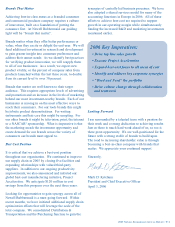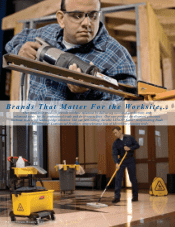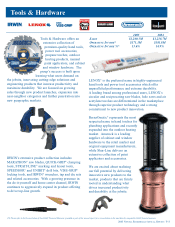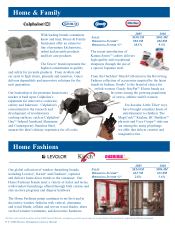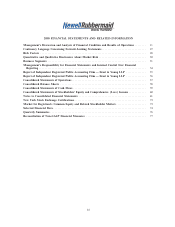Graco 2005 Annual Report Download - page 14
Download and view the complete annual report
Please find page 14 of the 2005 Graco annual report below. You can navigate through the pages in the report by either clicking on the pages listed below, or by using the keyword search tool below to find specific information within the annual report.the Company's schedule of corporate authority. The Plan is designed to reduce manufacturing overhead by
strategically sourcing and manufacturing products in lower cost countries. The Company began executing
the Plan in the fourth quarter of 2005 and recorded $51.3 million in non-cash restructuring charges. See
Footnote 4 to the Consolidated Financial Statements for additional information on restructuring.
The Plan is expected to result in cumulative restructuring charges totaling between $350 million and
$400 million ($295 millionÌ$340 million after tax), with between $170 million and $200 million
($145 millionÌ$170 million after tax) to be incurred in 2006. Approximately 60% of the cumulative
charges under Project Acceleration are expected to be cash charges. The Company expects annual savings
from the plan to exceed $120 million upon conclusion of the program. See Footnote 4 to the Consolidated
Financial Statements for additional information.
Additionally, the Company is committed to the deployment of Newell Operational Excellence. Newell
Operational Excellence is the process that the Company has developed using best practices from
methodologies such as Six Sigma, Kaizen, Kanban and other lean manufacturing principles. The Company
delivered approximately $87 million of productivity savings, excluding raw material inÖation, during 2005.
2006 Priorities
In 2006, management is focused on the following key objectives:
Invest in Strategic Brands to Deliver Top-Line Growth
The Company's emphasis will be to deliver sales growth through increased investments in marketing
and new product development on the strongest brands within its Invest businesses. The Company will
focus on developing best-in-class practices for innovation and branding. The Company's objective is to
build brands that really matter to its consumers. The Company will put in the systems to understand its
consumers in detailÌhow they use its products, what they value, and how to delight them or excite them.
The Company will invest in more innovation that diÅerentiates its products. The Company will have to
invest more in advertising and other consumer marketing to increase awareness as well as trial and repeat
purchases. Further, the Company will have to be able to measure the eÅectiveness of those increased
marketing investments.
Reduce Supply Chain Costs/Execute Project Acceleration
Through Newell Operational Excellence and previous restructuring, the Company has made signiÑcant
progress in reducing its supply chain costs and delivering productivity savings. The Company will broaden
the supply chain eÅorts to include purchasing and distribution & transportation. Project Acceleration is
designed to reduce manufacturing overhead and labor costs by strategically sourcing and manufacturing
products in lower cost countries.
Strengthen the Portfolio
The Company has made signiÑcant progress in strengthening its portfolio over the past three years.
The Company has made selective acquisitions of new product lines. In 2005, the Company acquired
DYMO, a global leader in designing, manufacturing and marketing on-demand labeling solutions, and
plans to integrate DYMO into its OÇce Products segment in 2006. This acquisition will strengthen the
Company's global leadership position in the OÇce Products segment by expanding and enhancing the
Company's product lines and customer base. In 2003, the Company acquired LENOX, a leading
manufacturer of power tools accessories and hand tools. The Company also divests businesses that do not
Ñt its business model (i.e., businesses that can sustain high margins and grow through investments in
brands and new product innovation). In 2004, the Company sold its U.S. picture frame business (Burnes),
its Anchor Hocking glassware business, its Mirro cookware business, its Panex Brazilian low-end cookware
business, its European picture frames business and its Little Tikes Commercial Playground Systems
business. In 2005, the Company sold its Curver business and entered into an agreement to sell its
13



